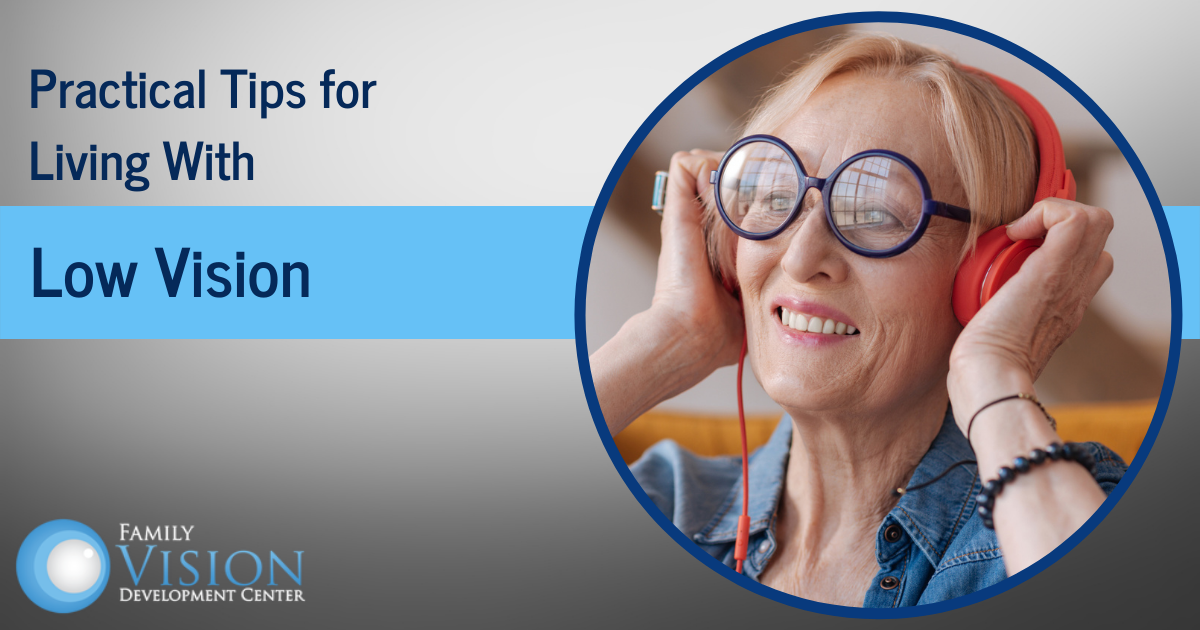Living with low vision can definitely be a challenge. As vision diminishes, even everyday tasks that used to be very simple become difficult to accomplish. Not everyone experiences the same kind of low vision, and some may have more severe symptoms than others. But anyone who is affected can benefit from these strategies to overcome the challenges they will surely face at one time or another.
What Can Cause Low Vision
Low vision is not total blindness. However, it is a loss of sight that is not completely correctable with glasses or contacts. Low vision can result in a range of sight loss, including blind spots, loss of peripheral vision, poor night vision or blurred or hazy vision.
There are a number of eye diseases and conditions that can cause someone to experience low vision. The most common include:
- Macular degeneration
- Glaucoma
- Cataracts
- Diabetic retinopathy
- Cancer of the eye
- Retinitis pigmentosa
- Traumatic brain injury
- Retinal detachment
Make These Changes Around the House
Living with low vision can make everyday tasks more difficult. But simple changes around the house can help simplify daily life while providing a safer environment. Consider the following easy tips:
- Get organized! Keeping essential items in the same place all the time makes it much easier to locate them quickly when needed.
- Keep clutter to a minimum to avoid accidents
- Move cords away from walkways
- Position the television to avoid glare on the screen
- Replace your flooring if necessary – avoid anything shiny, slippery or materials with busy patterns or stripes
- Install brighter lighting in important areas like the kitchen and bathroom.
- Use contrasting colors throughout the house. For example, different color furniture, light switches, accent walls or countertops can help improve visibility and define areas.
- Add colorful tape strips to the edges of each stair
- Minimize the possibility of tripping or falling by taping down carpets and using no-slip mats in the shower.
- Install hand railings on the stairs and grab bars in the shower or bath
- Keep plenty of low vision magnifying devices around the house in order to more easily read things like food labels, instructions or prescription bottles. Additionally, a magnifying mirror in the bathroom can help during your morning routine.
- Plug in night lights throughout the house to avoid accidents at night.
- Use clocks with large numbers. Or alternatively, you can even find clocks that speak the time out loud.
- Find your favorite magazines in large-print versions.
- If you find reading to be difficult, try audiobooks. Many websites, along with local libraries, offer free audiobooks in a wide variety of genres.
Get Regular Vision Exams
Modifying your home can make living with low vision easier. But the most important way to care for a vision disorder is to see your eye doctor regularly. When you visit us at Family Vision Development Center for a comprehensive vision exam on an annual basis, we can detect any changes in vision right away and recommend the appropriate treatment. Our patients with low vision have unique needs, and as their vision changes, we can discuss and prescribe effective low vision aids.
Family Vision Development Center is a full-service eye care provider and we care for patients of all ages. We offer a range of vision services such as comprehensive vision exams along with a variety of designer eyeglasses and contact lenses. Additionally, our specialized vision therapy programs are effective treatment options for post-concussive visual rehabilitation, treatment of binocular visual impairments and refining the visual skills of athletes to improve sports performance. Contact our office at 630-862-2020 to learn more and to schedule your appointment.
Family Vision Development Center is a full-service vision center offering innovative vision therapy services, post-concussive vision rehabilitation, comprehensive vision exams for eyeglasses and contact lenses, management of ocular diseases including glaucoma, diabetes, macular degeneration and cataracts, and a state-of-the-art optical center offering the latest designs in eyewear.

